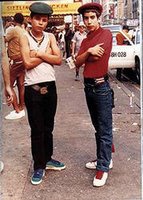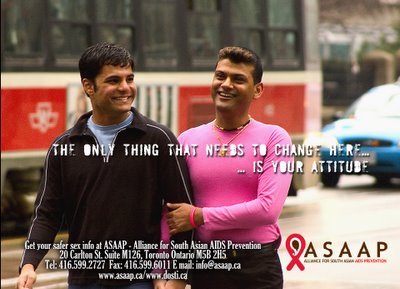I write this post, to articulate a theory which I have been musing upon for the last five years. My speculation may be dated, but sometimes time is needed to give necessary hind-sight.
Let me begin by stating a position I hold regarding
art. While many theories abound regarding aesthetics, the one which makes the most sense to me, is to say that art serves as a reflection of society. That art in turn, should either in form or content, represent some
truth regarding the time in which it is produced. As such, even when a period-piece movie is produced, it should not simply be trying to re-stage the past for us, but rather, the by-gone era should serve as a metaphor for something relevant today.
For the last five years, the sounds of the exotic east have filtered into hip hop. The voice of Lata is often sampled, an Indian flute is thrown in, or distinctive bhangra dhol lines are added. And why shouldn’t Indian beats influence hip hop? It would seem inevitable, go too any Indian jam,
and the hypeness of the music is immediately evident. And India is home to the world’s largest music industry. Indian culture has become fashionable in the runways, why not in music? Is this new musical urban sensibility, just a passing fad, a trend which merely points to how we are truly becoming a global village? It doesn’t appear to be simply a passing fad; Bollywood still is influencing new hip hop releases. While it may be a sign of the global village, I feel it is more of a sign of the reality of the world we live in, a reality in which there exists imperial America, which is actively occupying two Middle Eastern states.
Hip hop is musically speaking my first
love. While Hindi Filmi music was the soundtrack to my childhood, it was a genre that I would later return to in my teens and explore. Before that, Hindi music had simply been the music my parents had listened too, Lata’s voice was something I took for granted, akin to how my white friends regard the Beatles or the Rolling Stones. Hip hop moved me. It turned me on. The bass lines, scratching, samples, in general the whole culture, excited me at a level which was visceral.
Hip hop in both form and content has represented the truth of its times. So much so, that hip hop is a global phenomena, being the most popular form of youth counter culture worldwide. From the war-torn streets of Gaza, to the decadent metropolis of Tokyo, you will find kids rhyming on their blocks about their experiences, there unique reality. Of course, to call hip hop counter culture today, may not be accurate, as it has moved from the realm of the underground, to that of popular culture. Now, commercials abound, for products ranging from soft drinks to cars, which capitalize on the
mass appeal of hip hop.

Essentially the bastard child of dancehall, hip hop began in the 1970’s in inner city New York. DJ Kool Herc – a Jamaican immigrant living in New York – considered the father of hip hop, invented the hip hop sound, by isolating “breaks” in songs - the part where only the drums could be heard - and as such the hip hop beat was born. Over this beat the Master of Ceremonies, or M.C., would rhyme tales of bravado, relating every day experiences.
While, there are some great lyrists, I mainly fell in love with hip hop for its beats. The hip hop beat originally mainly relied upon sampling soul and funk songs from the 1950’s to the 1970’s. James Brown, probably is one of the most oft sampled artists in hip hop, in 1988 every major hip hop release, had a James Brown sample to boot. While on the surface it may be obvious as to why he would be popular, his songs have an electrifying funky quality, I feel there is more to it than just that. One can not simply stand and listen to James Brown, without standing still. His tracks cause one to inadvertently start nodding there head. James Brown recorded the
majority of his tracks during the civil rights movement in America. “
Say it Loud, I’m Black and I’m Proud” was the theme song to a proposed revolution, the backdrop to the raised fist of protest. As he recorded this track, outside his studio, America was in the midst of a confrontation of its race relations. How could this not influence the track, not simply in lyrical content, but in it’s form itself? “Say it Loud, I’m Black and I’m Proud” can not simply be infectious because of its production value, but also due the fact that it was manifesting the truth of its time.

Like I said, hip-hop was the music of inner city youth in New York. It developed and grew during the Regan administration, a time in which the black community was faced with the harsh economic realities that the government at hand brought forth. Realities that included gang violence, poverty, and project living, which rappers related through their rhymes. While original hip hop recordings, like "
Rappers Delight" were “party” songs, hip hop was a music of protest, if not explicitly, at least implicitly. It was a big middle finger in the air, to established notions of what music should sound like. The cutting up bit’s of old tracks, scratching of vinyl, and aggressive bass lines was a challenge to what was musically acceptable.
Further, by riffling through the catalogues of the likes of James Brown and Parliament, hip hop was in effect sampling the “soul” of the civil rights movement itself, so that it could echo in the present. When Pete Rock and C.L. Smooth released
“They Reminisce Over You (T.R.O.Y.)” in 1992 – an ode to fallen ghetto comrades which was popular not only as a club track but at funerals – which sampled the break from “Say it Loud, I’m Black and I’m Proud” they evoked the essence the original recording had captured, so to reflect the truth that was theirs in the present.
Near the end of the 1990’s hip hop had moved away from the sampling of old funk breaks. New producers like the Neptune’s and Timberland had taken to producing hip hop tracks, which were based on synthesized drum beats. Also, hip hop had moved away from being conscious based music which provided a commentary on the realities of the ghetto, to glorifying the excesses which occurred in the ghetto. Materialism had been a preoccupation in hip hop from the start; disenfranchised youth dreaming of fast cars and nice clothes delivering false stories of luxuries they did not have. As hip hop gained commercial appeal, the next-generation of rappers were able to realize these dreams. While these rappers may have originally started out in the hood, the hood no longer remained there stomping grounds. The likes of Puff Daddy and Jay Z now vacation in the Hamptons, with there respective business and spin-off clothing labels accounting for multi-million dollar revenues. While some prematurely declared that hip hop was dead, it had simply evolved. The tracks released during this time, I enjoyed for superficial reasons, because they were simply that, superficial. But to me, the sound, the appeal, the gut response to the music was gone. To me, hip hop had lost its soul.

In July of 2002 Truth Hurts released, “
Addictive”, a Dr. Dre produced song, which sampled the vocals of Lata Mangeshkar from the Hindi film “Jyoti”. Apparently, Dre had heard the song while randomly coming upon the movie while watching T.V., had the idea of sampling it, and the song went on to become one of the top 50 U.S. singles of that year according to billboard music charts. At the time of it’s release the invasion of Afghanistan was well on it’s way by the American military. In 2003 almost every major hip hop release contained at least one track, if not more, with an eastern influence, a situation akin to 1998 where every album had a James Brown sample. It was the same year that the American military began it’s invasion of the sovereign state of Iraq.
To me this development in hip hop was fascinating. I remember growing up the 1980’s – before the policy of multiculturalism had been instituted - when it was acceptable to be called a “paki” at school. My Indian culture was a source of embarrassment to me, and I recall being ridiculed for my curry food and the sing-song of Hindi films was the butt of jokes. Now, I would go to clubs, and people would “
lean back” to the rhythms that originated from the sub-continent.
While the black community in America, has by no means attained equality in this new millennium, the music that had been formulated by their youth two decades ago, had evolved from a music of protest to one of commercial excess. Across the Atlantic, in the middle-east, where a war is being waged for oil to allow for a SUV hungry nation to drive to it’s heart content, lies this generations truly disenfranchised. Hip hop producers having exhausted ransacking through their own “soul catalogue”, probably being only subconsciously aware, turned to sample the
imagined soul of a culture which was experiencing colonization. Similar in fashion to the appropriation of black culture by the likes of Elvis Priestley, American hip hop producers in turn had turned to appropriate a
imagined voice of struggle which currently was lacking within it’s own borders.
I say imagined on purpose, because, of course I realize that Indian music, is distinctly different from the musical traditions to be found in Afghanistan or Iraq. However, in the melting pot eyes of America, the far east appears as one blurry vision. Cultural appropriateness and understanding of subtleties that lie across the many nations of the middle-east and Asia are not understood. Indeed, when the video for Truth Hurt’s “Addictive” was released, it featured Truth Hurts and her dancers in typical Arab belly-dancer costumes, and the décor of the set was Arabic in nature. Continuing in the great Orientalist tradition, all things Muslim were confounded into one, and seen as exotic.
Was it wrong for hip hop to sample classic Bollywood tracks? No, of course not. I personally have enjoyed this particular cross pollination. Hip hop instinctively moved to sample the soul of Indian music, because the nature of world politics today. If not in content, in form, it represented the truth of our geo-political situation.
Now what makes a totally sick tune? When content and form both strive to show truth, like this track, “
Hustle Everyday” by U.K. act Def 1.









 I couldn’t believe it, and later picked up the paper and gazed at it dumbfounded. I felt a thrill at the subversive nature of the ad, as a few pages in there was an ad for pilgrimage travel to Saudi Arabia. I imagined thousands of conservative Pakistani’s opening up the paper and the ad being right in their face. Boo-yah! I applaud
I couldn’t believe it, and later picked up the paper and gazed at it dumbfounded. I felt a thrill at the subversive nature of the ad, as a few pages in there was an ad for pilgrimage travel to Saudi Arabia. I imagined thousands of conservative Pakistani’s opening up the paper and the ad being right in their face. Boo-yah! I applaud  Essentially the bastard child of dancehall, hip hop began in the 1970’s in inner city New York. DJ Kool Herc – a Jamaican immigrant living in New York – considered the father of hip hop, invented the hip hop sound, by isolating “breaks” in songs - the part where only the drums could be heard - and as such the hip hop beat was born. Over this beat the Master of Ceremonies, or M.C., would rhyme tales of bravado, relating every day experiences.
Essentially the bastard child of dancehall, hip hop began in the 1970’s in inner city New York. DJ Kool Herc – a Jamaican immigrant living in New York – considered the father of hip hop, invented the hip hop sound, by isolating “breaks” in songs - the part where only the drums could be heard - and as such the hip hop beat was born. Over this beat the Master of Ceremonies, or M.C., would rhyme tales of bravado, relating every day experiences. Like I said, hip-hop was the music of inner city youth in New York. It developed and grew during the Regan administration, a time in which the black community was faced with the harsh economic realities that the government at hand brought forth. Realities that included gang violence, poverty, and project living, which rappers related through their rhymes. While original hip hop recordings, like "
Like I said, hip-hop was the music of inner city youth in New York. It developed and grew during the Regan administration, a time in which the black community was faced with the harsh economic realities that the government at hand brought forth. Realities that included gang violence, poverty, and project living, which rappers related through their rhymes. While original hip hop recordings, like " In July of 2002 Truth Hurts released, “
In July of 2002 Truth Hurts released, “